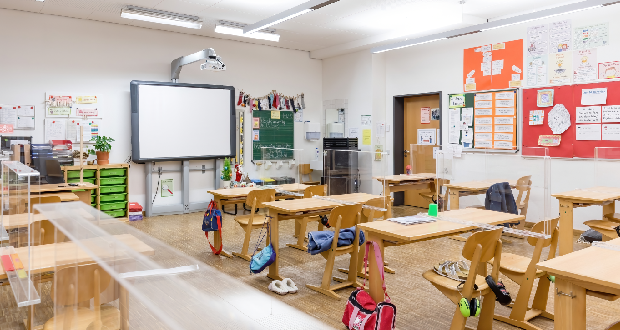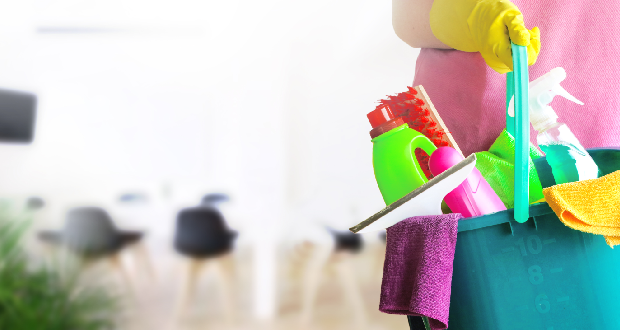
No products available in cart, click 'Go to Products Page' to add products
Go To Products PageClassrooms are the epicenter of learning, where today’s young minds are molded into tomorrow’s thinkers. But unfortunately, they are also one of the dirtiest places, harboring an unimaginable amount of dust, dirt, grime, germs, bacteria, and viruses due to high levels of human exposure.
Keeping a classroom clean and disinfected can be a challenge for janitorial staff, teachers, and even students. However, by adhering to a classroom cleaning checklist, schools can help ensure that classrooms are kept clean every day.
Using our daily and monthly classroom cleaning checklist will help you make sure the classroom is always clean for a hygienic learning environment.
Students, especially younger children, get messy while doing any activity. For example, kids can make a mess of eating, drawing, and playing by spilling food and drink, drawing on walls, and rough-housing in the playground dirt.
But with a weakened immune system, the same children might become vulnerable to various illnesses and diseases. Therefore, as a general rule, anything that children come into contact with frequently should be cleaned, disinfected, and sanitized with antiseptic liquid, disinfectant spray, multipurpose surface wipes.
Whether you are cleaning a kindergarten or high school classroom, maintaining a daily and monthly classroom cleaning checklist helps prevent the spread of diseases among students.
Collect and remove medium to large debris like crumpled papers, discarded pens, pencils, crayons, etc., and dispose of them in the proper trash receptacle.
Clear away scattered study materials (books, notebooks, journals, etc.) and stationery items, and store them properly in an organized manner. Carefully place personal items in a secure location where the owner may find them easily.
Unplug all the unused electrical outlets to not only conserve electricity but to also prevent any electrical fires. Students and teachers may sometimes need to remember to unplug the projector, fans, and other devices.
Wiping down frequently touched surfaces, tables, and chairs can be regarded as the most important cleaning task in the classroom cleaning checklist. We recommend wiping down surfaces, tables, and chairs used by students and teachers with Dettol antiseptic disinfectant liquid to clean, disinfect, and sanitize simultaneously.
Use a broom, vacuum cleaner, and disinfectant spray to clean the floors thoroughly by the end of the school, high school, or college day.
Dust and dirt from various external sources, such as shoes, can penetrate classrooms, can make the floors dirty and filled with countless germs and bacteria. A thorough mopping using multipurpose floor cleaners helps to remove deep-seated dust, dirt, germs, and bacteria.
Frequently touched surfaces, such as walls, chalkboards, etc., are among the most common ways to spread viruses among students. Therefore, regularly disinfect and sanitize all such surfaces daily with either antiseptic liquid or multipurpose surface wipes.
Disinfecting common touchpoints, such as doorknobs, light switches, cabinet handles, etc., once daily is a good hygiene practice. In addition, keep a disinfectant spray with you to sanitize these touchpoints to eliminate the large colonies of germs due to constant handling by different people.
While taking out the trash may seem straightforward, it is important to infuse the importance of recycling with the students. Ensure your classroom has a separate bag for garbage and recycling material following a recycling program. Also, remember to list the recycling in your classroom cleaning checklist!
At least once a week, disinfect low-touched surfaces and areas that are not regularly used or come in contact with students. Using a steam mop with several attachments can work wonders in lifting grime off such surfaces while sanitizing the area with steam.
Remove dust and dirt using a dry cloth. Next, disinfect these devices with multipurpose antibacterial surface wipes. Make sure you do not directly apply the disinfectant spray or liquid on the device, as it may cause them to malfunction.
Once a week, inspect shelves and cabinets and dust off any dirt or grime accumulated over the week. Shelves and cabinet handles should be cleaned and sanitized by disinfecting spray and surface wipes, especially when students use them frequently.
Chalk and ink can smudge the chalkboard and whiteboard, creating a layer that would make the boards look dull. Erasers can only do so much to remove chalk and ink, so a weekly cleaning of the chalkboard and whiteboard is recommended to keep them in good condition.
Windows and blinds can get particularly dusty. Keeping the dust out of the classroom is important as some students may have allergies. Make sure to dust and wipe down windows at least once a week.
Dusty ceiling fans and vents may cause many problems for kids suffering from allergies. Clean the fans and change the vents once a month. If the classroom has a sink or wash basin, clean it regularly using a non-toxic disinfectant liquid.
While cleaning the classroom involves several steps, you’ll find some of the most crucial steps mentioned below:
You can maintain cleanliness in your classroom by
Depending on what you decide to clean at the classroom, you'll need:
PLEASE NOTE: All reasonable steps have been taken to ensure the accuracy of the information and material contained in this presentation (“Material”); however, no warranty or representation is provided in respect thereof. Information contained in the Materials is for information and educative purposes only and should not be used as a recommendation or advice. Please refer to product packaging and information and guidance thereon at all times. In no event shall Reckitt Benckiser Group PLC and/or its affiliates be liable for any damages or any other consequence arising from the use of the Material.
Reckitt Pro Solutions represent a well-diversified portfolio of leading global brands for businesses like you to clean effectively and efficiently.






